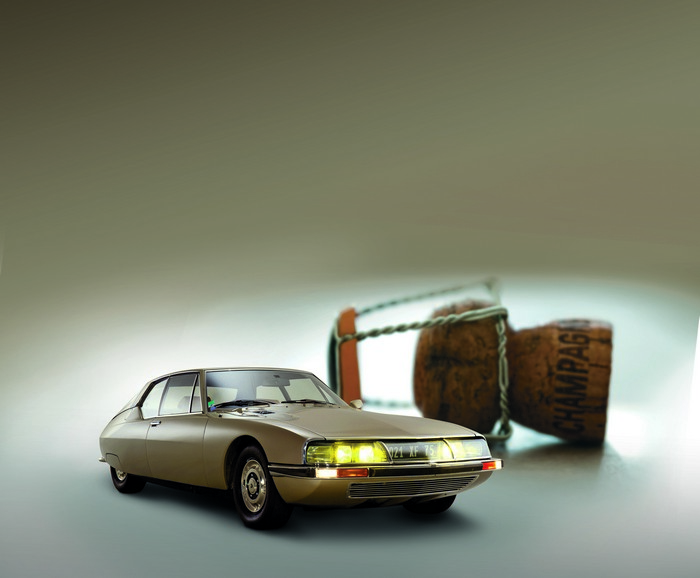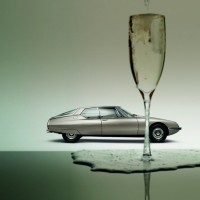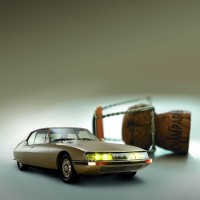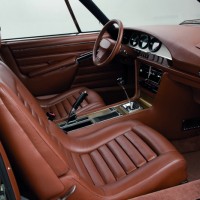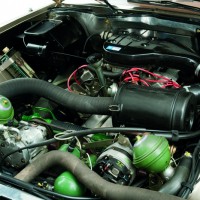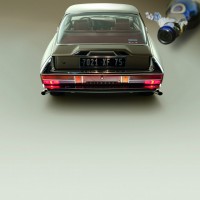What makes this Citroën SM special is that it is as close to a new car as is possible to be following a no-expense-spared restoration. It was given to the renowned Garage du Lac, run by Vincent Crescia in Switzerland, for a total mechanical and body rebuild.
New or refurbished parts were fitted throughout, and the gearbox, running gear, steering, wiring, hydraulic and cooling systems were all restored to new. The body was completely dismantled and elements that showed any defect were replaced, with the rest sanded, stripped and prepared before being repainted. Any accessory that was less than perfect was replaced.
To restore the interior, the owner went to Barron-Sellier in Lyon, who re-upholstered the car in tobacco-colored leather. They also put leather trim on the dashboard, steering wheel, glove box, sun visor, rear shelf and part of the pedals. The wool carpets are also trimmed in leather.
Today, the car is part of a British collection that was featured in Octane magazine. Presented in metallic brown with alloy wheels, this coupe is equipped with the famous 2.7-liter V6 170 bhp engine developed by Maserati. Mated to a 5-speed manual gearbox, the engine powers the car to 220 km/h (136 mph) in the total comfort and safety provided by the hydraulic system. These qualities have brought the car great success in rallying, including victory in the 1971 Rallye du Maroc.
This coupe is without a doubt one of the most stunning examples it is possible to buy. By returning this car to as-new condition, the owner has paid a fitting tribute to one of the most extraordinary Gran Turismo cars of its generation, both technically and stylistically.
SCM Analysis
Detailing
| Number Produced: | 12,920 |
| Original List Price: | $11,700 |
| Tune Up Cost: | $300 |
| Website: | http://www.citroensm.org |
This car, Lot 319, sold for $170,672, including buyer’s premium, at the Artcurial Rétromobile auction in Paris on February 8, 2013.
The Citroën SM has long been one of the collector-car world’s sad stories. Born with the high ambition to restore to the roads a powerful, fast, elegant and dramatic French motorcar, the heir to the great Grand Routiers of the 1930s to the 1950s, it was also one of the few examples of an automotive merger actually realizing useful synergies.
Citroën bought Maserati in 1968 for the sole purpose of having a source for a more appropriate engine for a grand tourer than their own agricultural 4-cylinder. They not only got the perfect V6 engine from Maserati, but the car was positioned in the market below the heart of the Maserati line and costs were optimized by placing the same engine in the Maserati Merak.
The SM was also a showcase for not only the well-known advanced engineering concepts Citroën had been using for years, but it also added pioneering variable-assist power steering, a rain-sensitive automatically adjusting windshield wiper, outstanding braking capability, optional ultra-lightweight composite resin wheels and a top speed of over 130 mph. The SM’s reasonable success in rally competition was proof of the durability and strength of the design. The car’s “failure” in the marketplace can be clearly attributed to the combination of federal safety legislation and the first energy crisis of the 1970s — combined with the sale of Citroën to the determinedly unimaginative Peugeot company in 1974. It would be obvious to any observer that after Maserati was sold off and DS production ended, the SM would be history.
Most have needs, but not this one
The website of the French SM Club has a Guide to Buying section. It begins: “Is the car in working condition? The car is complete? Are the papers OK? If there is a summary of registrations, check the most recent to get an idea of the last time it was used.” It goes on to advise that the engine costs about $13,000 to rebuild, plus 40 hours for removal and re-installation. The 205/70 Michelin XWX tires are very expensive, and if you want or have to replace a set of the rare, super-desirable resin alloy wheels, they will set you back about $4,000 each. The guide continues with the usual spots to check for rust, and advice on mechanical pitfalls in the gearbox and suspension hardware. Going inside, the guide tells us that an original radio costs $650 to $1,050 if you have to source one. It makes no mention of the hydraulics, which, of course, is not a very big deal in France.
What that list does tell you is that this isn’t generally the buying advice that goes along with cars that are either well-preserved and cherished originals or superbly restored jewels. Most of the SMs still living are cars with needs, both obvious and hidden.
Without a wide network of support sources for maintenance, many quickly sank on more than their suspensions after dealer service was no longer an option. It is one of the reasons that they developed a scary reputation as unreliable money pits. Any high-performance car that isn’t regularly run and maintained will become a nightmare, and that is not exclusive to the SM.
The best restoration possible
There are obviously more knowledgeable and experienced restoration and maintenance shops for these cars in Europe than in the U.S., and one of the best known and most respected is the Garage du Lac in Saint-Blaise, Switzerland. The restorations they perform on Citroëns, especially coachbuilt models, are legendary. When they come to the auction market in Paris they tend to “ring the bell,” as the expression goes, and this 1971 SM was no exception.
I saw the car on the Artcurial stand at the Rétromobile show, and it was truly impressive. I love these cars in this color combination of Metallic Brown with Tobacco leather, the same as was featured in the first catalog. The incredibly evocative images of this sleek coupe traveling through Paris at night are burned into my psyche. The body panels were impeccable, the trim unmarked, the interior just inhabited enough to make it inviting. It sat evenly on its wheels and not a drip or weep could be seen under the hood or on the floor for the days it sat in court.
It carried an estimate of €60,000 to €100,000 ($79,800–$133,000) at no reserve. That’s a healthy price for a non-coachbuilt SM. It’s not impossible to conceive, as Bonhams sold a convertible four-door SM by Chapron, one of the two “Présidentielles,” for $217,350 in Paris in 2011 — a figure that remains the record at auction for an SM.
It’s worth mentioning here that I noted the euro was at $1.33 on the day of the sale, although inexplicably Artcurial uses the exchange rate of $1.27 on their website — thereby listing this sale at $162,511. I only wish it had been that good a rate.
As impressive as the sales price is, take into account that the 249,428 CHF spent on the restoration basically translates to the same amount in dollars, as the currencies have been more or less at parity since mid-2010. So, it is likely that the SM was bought for a little less than 70% of the cost of the work done, with the car thrown in for free.
A market changer?
Back in August 2010, a good friend and client bought an SM from Gooding & Company’s Pebble Beach sale. Also finished in Metallic Brown with Tobacco, he paid a not inconsiderable $50,600 for it (see Comps for details). Various people thought him nuts; I was not among them. The car, well rebuilt and maintained by SM World in Southern California, has proven to be both dependable and reliable. It also has been a thrilling vintage rally mount for him on a number of occasions. As is so often the case, the SM’s loudest detractors are those with no firsthand experience of the car. Properly set up, maintained and used regularly, they are the equal of their contemporary competition and offer a truly unique driving experience.
This sale is obviously an outlier. SMs are not now $150,000 cars on a regular basis. We will have to see if this transaction prompts other owners with superb cars to bring them to market — and encourages owners who want to keep them to invest serious money into making them as good as they deserve to be.
We’ve seen this now with Alfa Romeo Sprint Speciales, Lancia Aurelia B24 Spiders and convertibles, Maserati 3500GTs and several other perennially undervalued models where the market moves in quick steps. That’s the key — the market always moves in steps; if indeed the SM is being re-evaluated, we will have to see quite a few intermediate sales to prove the fact.
For now, this sale is unrepeatable. ?
(Introductory description courtesy of Artcurial.)
